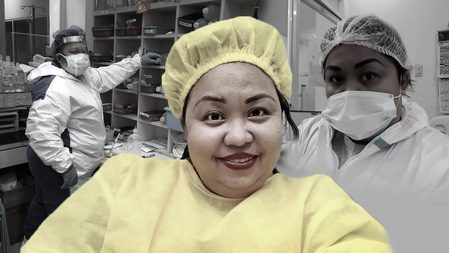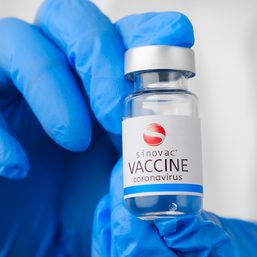SUMMARY
This is AI generated summarization, which may have errors. For context, always refer to the full article.
The payment of benefits to health care workers during the COVID-19 pandemic has been a rocky discussion.
The government says more than P14 billion worth of benefits have been disbursed, but in August 2021 a group of health workers in various hospitals said they were planning to stage a mass protest over unreleased benefits. Similar protests were seen in 2020.
Now, the Commission on Audit says P539 million worth of payment of allowances did not have complete documentary support. There was also a P214 million payment made to “unqualified recipients.” (READ: Congress: If health workers did not receive benefits ‘that’s fraud, that’s corruption’)
There are policies that specify who are considered COVID-19 healthcare workers and how much is guaranteed to them for risking their lives to work during the pandemic.
The COVID-19 active hazard duty pay (AHDP) and special risk allowance (SRA) have legal basis in the Bayanihan 1 and 2 laws. These are additional benefits on top of existing hazard pay grants, such as the ones under the Magna Carta of Public Health Workers and Joint Circular No. 1, series of 2016, of the health and budget departments.
Here’s what you need to know about these benefits, based on what is outlined in administrative orders and other measures.
Who is qualified to receive COVID-19 hazard pay?
The AHDP under President Rodrigo Duterte’s Administrative Order (AO) No. 35 is for “frontline human resources for health (HRH)” only.
Based on the law, “frontline human resources for health (HRH) are medical, allied medical, and other personnel in the public sector who are involved in the national health care response to mitigate the transmission of COVID-19 and prevent further loss of lives.”
Thy include:
- Civilian employees with regular, contractual, or casual positions, whether full or part-time
- Workers in contract of service (COS) or job order (JO)
- Barangay health workers (BHWs) assigned to hospitals, laboratories, or medical and quarantine facilities, and whose official duties and responsibilities are directly related to the government’s COVID-19 response
- Frontline HRHs determined by local government units
Frontline HRHs are those who physically report for work at their assigned work stations. This must be during prescribed official working hours during the state of national emergency.
AO No. 35 says AHDP does not cover:
- Consultants and experts engaged for a limited period to perform specific activities or services
- Workers engaged through job contracts (pakyaw) and those paid on piecework basis
- Student workers and apprentices
- Individuals or groups of individuals whose services are engaged through COS or JO, including BHWs not assigned to hospitals, laboratories, and medical or quarantine facilities
Who is qualified to receive COVID-19 special risk allowance?
The COVID-19 SRA is for public and private healthcare workers who directly cater to, or are in contact with, COVID-19 patients, according to Bayanihan 2 and AO 36. If passed, Bayanihan 3 will continue the policy.
The definition of public health workers qualified for SRA follows the same definition for AHDP. For private health workers, these are workers who are assigned in designated COVID-19 units of hospitals, laboratories, or medical and quarantine facilities certified by the Department of Health.
Both public and private health workers qualified for SRA physically report for work, and “provide critical and urgent services to respond to the public health emergency during the state of national emergency.”
The exclusions for SRA are the same as those excluded under AHDP.
Bayanihan 3 proposes to allow for the payment of SRA even during the period workers are “unable to serve due to COVID-19 hospitalization” during the period of a state of national emergency.

How much is the COVID-19 hazard pay?
The government revised the benefits as time went by.
If the health worker worked during enhanced community quarantine (ECQ) beginning March 17, 2020, and modified enhanced community quarantine (MECQ), the amount is P500 per day per person, according to AO 26 and the Department of Budget and Management.
In AO 35, which was signed on November 16, 2020, hazard pay was revised to be up to P3,000 per month.
The P3,000 will be prorated, based on the number of days the frontline HRH physically reports for work in a month covering the period September 15 to December 19, 2020.
This is the formula for AHDP:

This benefit is exempt from income tax.
How much is the COVID-19 special risk allowance?
In the first guidelines for COVID-19 SRA, AO 28, the grant should be a one-time grant equivalent to a maximum of 25% of the worker’s monthly basic salary. This is for the qualified workers who went to work beginning March 17, 2020, in ECQ and MECQ areas.
This should be prorated, based on the number of days the health workers physically report for work during the ECQ period.
AO 36, also signed on November 16, 2020, made the COVID-19 SRA no longer a one-time benefit. It became a monthly grant not exceeding P5,000 a month for every month health workers serve during the state of public health emergency.
This is the formula for SRA:

The period covered for AO 36 was September 15, 2020, to June 30, 2021.
Like the AHDP, the SRA is exempt from income tax.
Need for expanded qualifications
On Wednesday, August 18, senators said that all health workers, whether they are directly treating COVID-19 patients or not, should also receive special risk allowance since they are all exposed to the risk of contracting the virus.
Even as Bayanihan 2 has expired, Health Secretary Francisco Duque III says the government is still collating the list of eligible healthcare workers to receive SRA.
Qualified health workers should also receive meals, accommodation, and transportation allowance, life insurance, and sickness and death compensation, apart from hazard pay and SRA. – Rappler.com
Add a comment
How does this make you feel?


![[Rappler’s Best] US does propaganda? Of course.](https://www.rappler.com/tachyon/2024/06/US-does-propaganda-Of-course-june-17-2024.jpg?resize=257%2C257&crop=236px%2C0px%2C720px%2C720px)



There are no comments yet. Add your comment to start the conversation.